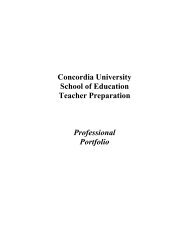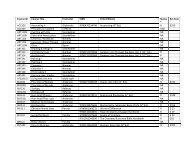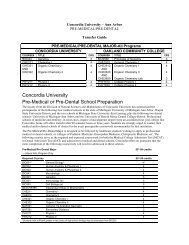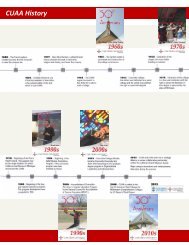2009â2010 Academic Catalog - Concordia University Ann Arbor
2009â2010 Academic Catalog - Concordia University Ann Arbor
2009â2010 Academic Catalog - Concordia University Ann Arbor
You also want an ePaper? Increase the reach of your titles
YUMPU automatically turns print PDFs into web optimized ePapers that Google loves.
<strong>Concordia</strong> <strong>University</strong> <strong>Ann</strong> <strong>Arbor</strong> 2009–2010 <strong>Academic</strong> <strong>Catalog</strong><br />
Guided Studies<br />
A course which has an approved syllabus but is not available during the time period required by the student to<br />
graduate may be taken as a guided study with approval of the instructor and permission of the appropriate dean<br />
and the VP <strong>Academic</strong>s. Students will be assessed a guided study fee for courses which are considered electives.<br />
Certain criteria are required and applications are available in the Registrar’s Office.<br />
Independent Studies<br />
Independent study is a form of self-directed learning that goes beyond coursework that is offered at <strong>Concordia</strong><br />
<strong>University</strong> and is pursued by a student following a written plan of study developed in consultation with a<br />
supervising instructor. Independent Study Applications are available in the Registrar’s Office and must be<br />
approved by the Vice President, <strong>Academic</strong>s.<br />
Withdrawing from the <strong>University</strong><br />
Any student that wishes to withdraw from the university should begin the withdrawal process with the Office of<br />
<strong>Academic</strong>s. The student will be asked to complete a withdrawal form to obtain important information. An exit<br />
interview will be conducted. Failure to complete these procedures may result in additional fees, a hold on the<br />
release of official transcripts, and/or complications with student loan deferment.<br />
<strong>Academic</strong> Advising<br />
All students will be assigned an academic advisor. Students are given the opportunity to select specific faculty<br />
advisors in their declared major, minor or program to assist in the explanation of academic requirements and<br />
planning their coursework at <strong>Concordia</strong> <strong>University</strong>. All students should have a four year academic plan<br />
developed with their advisors by the end of their first year Students may select a new advisor at any time by<br />
picking up a Declaration of Advisor Form in the Registrar’s Office and obtaining the signature of their new<br />
advisor.<br />
Final responsibility for meeting all graduation requirements rests with the student.<br />
Grading System<br />
Grades are assigned for all courses after completion. They reflect a student’s achievement as indicated by class<br />
performance and examinations. <strong>Concordia</strong> uses the following letter grades and quality points:<br />
A = 4.0000 C = 2.0000<br />
A- = 3.6667 C- = 1.6667<br />
B+ = 3.3333 D+ = 1.3333<br />
B = 3.0000 D = 1.0000<br />
B- = 2.6667 D- = 0.6667<br />
C+ = 2.3333 F = 0.0000<br />
• I = Incomplete: This grade is assigned, at the discretion of the instructor, when the course requirements have<br />
not been met. It must be removed by a date specified by the instructor that is no more than 120 days after the<br />
traditional course ends or the Incomplete automatically converts to the alternate grade specified by the<br />
instructor.<br />
• W = Authorized Withdrawal: zero quality points, no credit earned, no affect on GPA<br />
• P = Pass: zero quality points, credit earned, no affect on GPA<br />
• NC = No Credit: zero quality points, no credit earned, no affect on GPA<br />
• AU = Audit: zero quality points, no credit earned, no affect on GPA (see “Auditors” above)<br />
If a student believes an error was made concerning a course grade, the student should contact the instructor<br />
immediately. The procedure for formally appealing a course grade is available at the Registrar’s Office.<br />
Quality points are allocated for each credit earned to provide numerical evaluation of a student’s scholastic<br />
record. Quality points for each credit are assigned as indicated above. To determine quality points for a course,<br />
simply multiply the credit hours by the quality points allotted for the assigned grade.<br />
Pg. 22 of 118












